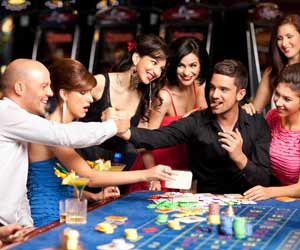Casino Craps
Craps developed out of the old English game hazard, which came to America in the early eighteenth century. Hazard proved too tedious for American players, so the rules were altered, after which the game’s popularity soared.

Now at least 50 million players annually bet over $200 million on craps. With its exciting and fast play, this game often attracts a huge crowd to watch the action.
A casino craps table is shaped like a large billiards table, with a sunken surface. A layout printed on the table illustrates all possible bets (see figure). The main elements in craps are the dice, the shooter who throws the dice, and the number seven. The new shooter begins the game by throwing the dice across the table until they hit the far wall and bounce to show a number. Seven is the most frequently thrown number because it can be produced by more combinations than any other number. The number seven is also important in craps as it relates to the “point” and the “come-out roll.” The point is a four, five , six, eight, nine, or ten rolled in a come-out. And the come-out is the most important roll of the game. It determines the outcome of most of the wagers and occurs in a variety of ways: after a new shooter arrives; when a seven, eleven, two, three, or twelve is rolled; if the point is established and repeated before a seven is rolled; or if a shooter “sevens out” or rolls a seven before repeating the point. The dice pass to a new shooter when the previous shooter commits a seven out. However, players may relinquish the option of shooting, voluntarily giving up the dice before the end of their turn, if they choose. There are many wagers in craps. The following will touch on the main bets as played in American casino craps.
The point is a four, five , six, eight, nine, or ten rolled in a come-out. And the come-out is the most important roll of the game. It determines the outcome of most of the wagers and occurs in a variety of ways: after a new shooter arrives; when a seven, eleven, two, three, or twelve is rolled; if the point is established and repeated before a seven is rolled; or if a shooter “sevens out” or rolls a seven before repeating the point. The dice pass to a new shooter when the previous shooter commits a seven out. However, players may relinquish the option of shooting, voluntarily giving up the dice before the end of their turn, if they choose. There are many wagers in craps. The following will touch on the main bets as played in American casino craps.
Line bets, placed on either the pass line or the don’t pass line, are the most popular. These bets occur before the come-out roll. The pass line bet wins if a seven or eleven is rolled on the come-out, or if a point is established and repeated before a seven appears. The bettor loses if a shooter “craps out” (a two, three, or twelve is rolled on the come-out), or a seven appears before the point is repeated. Don’t pass line bets, essentially the reverse of pass line bets, win if a two or a three is rolled on the come-out, or a seven shows before the point is repeated.
The bettor loses if a seven or eleven appears on the come-out, or a point repeats itself before a seven. If a twelve is rolled, the bettor neither wins nor loses.
Come and don’t come bets receive much less play or action since many players feel unsure about how to place them. These bets are similar to the pass line and don’t pass line bets, only they occur after the come-out roll instead of before. A come bet wins on a seven or eleven and loses on two, three, or twelve. If any other number, referred to as the “come number,” appears, the dealer moves the wager to the corresponding place-number box on the layout. Then the wager wins if the come number repeats before a seven. Don’t come wagers win if a two or three is rolled, and lose if a seven or eleven is rolled. A twelve results in neither a win nor loss. Otherwise, the chips go into the place- number box corresponding to the come number. The wager wins if a shooter rolls a seven before the come number.
The craps table is usually the most active table in the casino with just as many people playing as standing around observing. Players tend to let loose and the dealers become part of the excitement, helping to produce a raucous atmosphere at a table.

